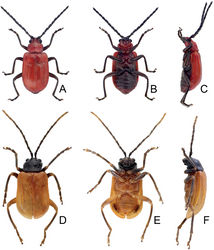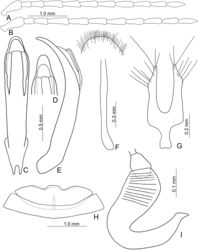Japonitata jungchani
| Notice: | This page is derived from the original publication listed below, whose author(s) should always be credited. Further contributors may edit and improve the content of this page and, consequently, need to be credited as well (see page history). Any assessment of factual correctness requires a careful review of the original article as well as of subsequent contributions.
If you are uncertain whether your planned contribution is correct or not, we suggest that you use the associated discussion page instead of editing the page directly. This page should be cited as follows (rationale):
Citation formats to copy and paste
BibTeX: @article{Lee2022ZooKeys1125, RIS/ Endnote: TY - JOUR Wikipedia/ Citizendium: <ref name="Lee2022ZooKeys1125">{{Citation See also the citation download page at the journal. |
Ordo: Coleoptera
Familia: Chrysomelidae
Genus: Japonitata
Name
Japonitata jungchani Lee, 2022 sp. nov. – Wikispecies link – ZooBank link – Pensoft Profile
Types
Holotype ♂ (TARI), Pingtung, Tahanshan (大漢山), 1450 m, 12.IV.2020, leg. Y.-T. Chung. Paratypes. 1♀ (TARI), same locality, 4.IV.2010, leg. K.-D. Ho; 1♀ (TARI), same locality (= Jinshuiying 浸水營), 6.VI.2011, leg. J.-C. Chen; 1♂ (TARI), same but with “22.V.2012”; 1♀ (TARI), Taitung, Lichia trail (利嘉林道), 1000 m, 10.V.2018, leg. B.-X. Guo.
Description
Length 5.8–6.3 mm, width 3.1–3.3 mm. General color (Fig. 1D–F) reddish brown; head and prothorax black; legs dark brown. Antennomeres II–XI filiform but stout in males (Fig. 4A), ratios of lengths of antennomeres I–XI 1.0: 0.4: 0.6: 0.8: 0.8: 0.8: 0.8: 0.8: 0.8: 0.7: 0.8; ratios of length to width from antennomeres I–XI 2.5: 1.7: 2.1: 2.8: 2.6: 2.9: 2.9: 3.2: 3.2: 3.1: 3.9; stout antennae in males similar in females (Fig. 4B), ratios of lengths of antennomeres I–XI 1.0: 0.4: 0.5: 0.8: 0.8: 0.8: 0.8: 0.7: 0.7: 0.7: 0.8; ratios of length to width from antennomeres I–XI 2.7: 1.6: 2.0: 3.0: 3.1: 3.0: 3.1: 3.1: 3.2: 2.9: 4.0. Pronotum 1.5–1.6 × wider than long; disc with scarce, fine punctures at sides, reduced medially, with transverse groove near base, medially abbreviated, laterally connected with short longitudinal groove on basal margin; lateral margins slightly rounded, widest behind apices; apical margin slightly concave and basal margin slightly convex. Elytra 1.4 × longer than wide; disc with confused, dense, fine punctures; with one small tubercle behind scutellum; with one distinct longitudinal ridge from humeral calli, parallel with lateral margin, abbreviated subapically; with one additional ridge also from humeral calli, distinct, directed medially; lateral margins moderately rounded, widest at apical third, apices divergent. Aedeagus (Fig. 4C–E) extremely slender, 6.4 × longer than wide; widest at apical 1/6, gradually narrowed toward base, moderately narrowed at apical 1/6, apex widely rounded, slightly and medially depressed; strongly, apically curved in lateral view; tectum wide, longitudinal, apex recurved; no endophallic sclerites. Apical margin of abdominal ventrite V in males with distinct median lobe (Fig. 4H) narrow, apical margin slightly recurved, with long median internal ridge at middle of basal margin, from base to middle; basal margin normal. Gonocoxae (Fig. 4G) longitudinal and connected basally, with narrow furrow between gonocoxae; each gonocoxa narrowed subapically, apex narrowly rounded, with eight long apical setae; base weakly sclerotized and narrow. Ventrite VIII (Fig. 4F) in females with apex weakly sclerotized, small, apical margin slightly irregular; with dense short apical setae; spiculum extremely elongate. Spermathecal receptaculum (Fig. 4I) swollen, not separated from pump; pump long and curved, with apical process curved; sclerotized spermathecal duct extremely short, separated from receptaculum.
Diagnosis
This new species is similar to J. bipartita Chen & Jiang, 1986 from China (Shaanxi and Fujian) with reddish brown body and black head and prothorax. It differs in having black antenna with the three apical antennomeres reddish brown, and dark brown fore and middle legs.
Host plant and biology
Unknown, but one adult was collected by sweeping flowers.
Etymology
The new species name is dedicated to Mr. Jung-Chan Chen (陳榮章), the first person to collect type specimens.
Distribution
South Taiwan including Pingtung and Taitung counties.
Original Description
- Lee, C; 2022: The genus Japonitata Strand (Insecta, Coleoptera, Chrysomelidae, Galerucinae) in Taiwan: a redefinition of the genus and descriptions of two new species ZooKeys, 1125: 171-192. doi
Images
|

